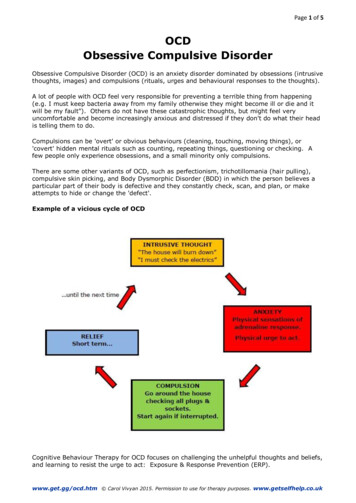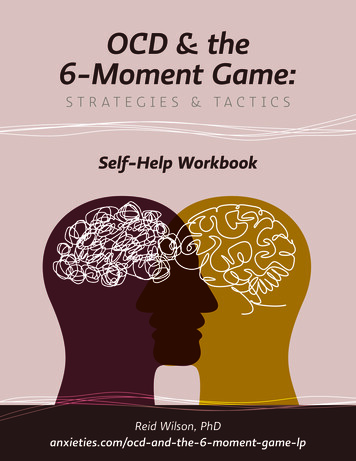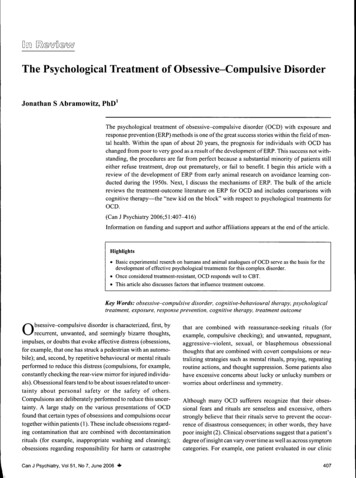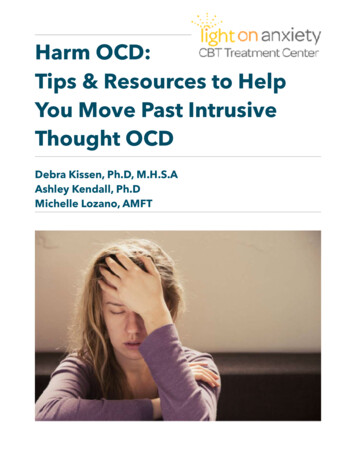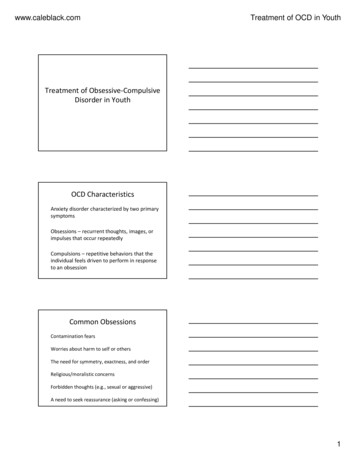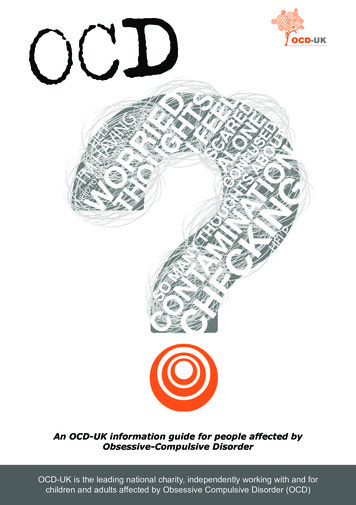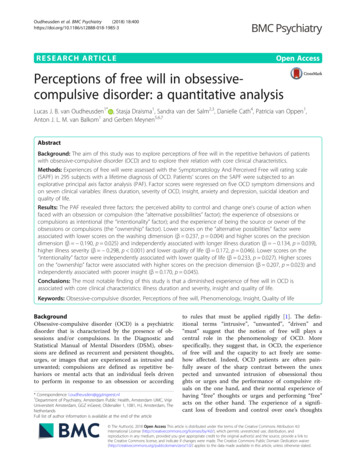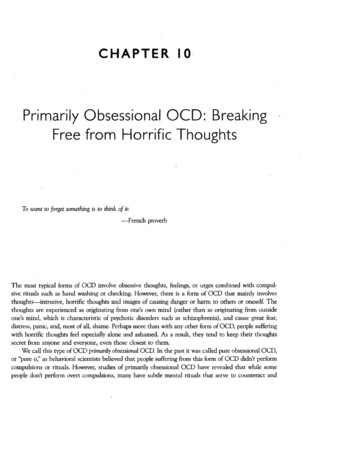
Transcription
CHAPTERIO·PrimarilyObsessionalOCD: BreakingFree from Horrific ThoughtsTo want to forgetsomethingis to think of it:-FrenchproverbThe most typical forms of OCD involve obsessive thoughts, feelings, or urges combined with compulsive rituals such as hand washing or checking. However, there is a form of OCD that mainly involvesthoughts-intrusive, horrific thoughts and images of causing danger or harm to others or oneself. Thethoughts are experienced as orjginating from one's own mind (rather than as originating from outsideone's mind, which is characteristic of psychotic disorders such as schizophrenia), and cause great fear,distress, panic, and, most of all, shame .Perhaps more than with any other form of OCD, people sufferingwith horrific thoughts feel especially alone and ashamed. As a result, they tend to keep their thoughtssecret from anyone and everyone, even those closest to them.We call this type of OCD primarily obsessionalOCD. In the past it was called pure obsessional OCD,or "pure o," as behavioral scientists believed that people suffering from this form of OCD didn't performcompulsions or rituals. However, studies of primarily obsessional OCD have revealed that while somepeople don't perform overt compulsions, many have subtle mental rituals that serve to counteract and
The OCD Workbookneutralize the discomfort of their unwanted, intrusive ·thoughts (Steketee 1993; Freeston and Ladouceur1997). For the purposes of this book, we'll consider primarily obsessional OCD to be OCD with horrificthoughts alone, as well as OCD with horrific thoughts and accompanying mental rituals. Let's look ata few examples of primarily obsessional OCD.Paula, age twenty-fiv , was playing with her beloved cats while smoking a cigarette. Out of theblue, the thought popped into her mind of burning a cat with the cigarette. The thought horrifiedher, prompting intense feelings of guilt. She wondered over and over, "How can I think such thoughts?Maybe I don't really love my cats. I must be a horrible person to think of doing that!" From then on,caring for her cats was nerve-wracking because she felt that they were in danger just because of beingnear her. She avoided touching her animals except when absolutely necessary.Perhaps you recall Angelita, from chapter 1, who was slicing tomatoes when suddenly a horrificthought popped into her head: "What if I lost control of myself and plunged this knife into my child'sneck?" Horrified by the thought, she whisked her two-year-old daughter out of the kitchen. Over thecourse of several days she placed gates at the entrances to the kitchen to prevent her daughter fromcoming into the kitchen while she was using knives, and eventually she removed all the knives fromher home.Anthony, a twenty-six-year heterosexual sales associate, had intrusive thoughts of losing controland groping the genitals·of good-looking men who stood near him at work. He spent up to two hourseach day conjuring up images of having sex with other men in order to reassure himself that he wassufficiently disgusted by the images. Only once he was satisfied about his response could he resume hisactivities. If he didn't achieve the "right" feeling, he had to keep on imagining the images over and overuntil he felt sufficiently disgusted. His compulsions started to interfere with his productivity at work,and his job was in jeopardy.Mario, a forty-eight-year-old teacher who was devoutly religious, had disturbing, intrusive thoughtsinvolving images of Jesus and the Virgin Mary. Often his thoughts involved sexual encounters withthem. The images were embarrassing and humiliating. He felt extremely guilty, eijpecially since theytended to increase when he was in church. His thoughts made him feel unworthy, so he quit going tochurch.Joshua, a thirty-three-year-old physician, had been m rried a year when his wife gave birth to theirfirst child. One night while watching his baby girl sleeping peacefully, the intrusive image of touchingthe child's genitals popped into his mind. Feeling guilty, embarrassed, and ashamed, he started avoidingany physical contact with the child. He didn't dare explain the reason to his wife, and she began to ·wonder why he refused to change the baby's diapers or even hold her.These are but a few of the myriad types of horrific thoughts. Here are some other examples:162 What if I assault my teacher with a sharp pencil? What if I poke my friend in the eye with a pick? What if I lose control and shout a rac-ialepithet? What if I lose control and harm myself? What if I dump scalding water on my baby?
Primarily Obsessional OCD: Breaking Free from Horrific Thoughts What if I think a bad thought about God? What if I lose control of myself and go crazy? What if I drive my car into oncoming traffic?THE NATURE OF HORRIFIC THOUGHTS INPRIMARILY OBSESSIONAL OCDWhile horrific thoughts can be extremely disturbing, they aren't actually dangerous. Decades of experience of dozens of clinicians treating thousands of patients with primarily obsessional OCD clearlyconfirm this. The thoughts all have the same theme: that you will somehow lose control of yourself,your faculties, and your normal, intact sense of judgment about what's right and wrong and act on thehorrific thought in a manner that's entirely uncharacteristic of your everyday actions and behavior. Let'stake a closer look at what this form of OCD is about.People with primarily obsessional OCD are extremely unlikely to carry out the horrificacts and urges that pop into their heads. Dr. Hyman, who has worked with over 1,000 patientswith primarily obsessional OCD over the last two decades, has been struck by the remarkable consistency of these individuals. Regardless of whether the thought involves violent or sexual images, peoplewith primarily obsessional OCD are not in danger of acting out these unwanted horrific thoughts. Peoplewho do act on such thoughts-criminals and sexual predators-have what is known as antisocial personality disorder. They lack a conscience and, unlike people with OCD, tend not to worry about theirhorrific thoughts or the possibility that they might act upon them. On the other hand, people withprimarily obsessional OCD almost always tend to display an excess of concern about doing things "right"and according to the rules. Likewise, they tend to rigorously avoid doing things "wrong" and apply overlyrigid, unforgiving standards to everything they think, do, and say. Clearly, people with primarily obsessional OCD have a problem with doubt, worry, and fear of their own thoughts, rather than a likelihoodof doing bad things or potentially committing crimes.People with primarily obsessional OCD are not in danger of "snapping." It is common forpeople with this type of OCD to convince themselves that the presence of persistent unwanted thoughtsis evidence that they could or even are likely to suddenly lose all self-control and commit horrific,harmful acts. Despite the incredible degree of discomfort, fear, and frustration these thoughts bringabout, no evidence of OCD patients "snapping" exists.Compulsions make it worse. To control the anxiety . and discomfort produced by horrific thoughts,people with primarily obsessional OCD often carry out subtle, covert compulsions that aren't obviousto others. Examples are silently repeating a prayer over and over or compulsively replacing the horrificimage with a neutral or positive one in ah attempt to neutralize the anxiety associated with the thought.This strategy does two things: It relieves them of the intense gtiilt associated with having the thoughts163
The OCD Workbookin the first place, and it provides a momentary sense of control and reassurance that they won't act outin the manner depicted by the thought. The problem is that the struggle to contain and control thesethoughts only intensifies the stranglehold of the very thoughts the person is trying to get rid of.The thoughts are not the problem; the r sponse to them is. Dr. Hyman's clinical experiencewith people with primarily obsessional OCD has repeatedly demonstrated that the disturbing ideasdepicted in the thoughts are actually in opposition to the person's true character, desires, and intentions. In fact, it appears that these ideas persist because they are so divergent from the true desires,intentions, and nature of the person suffering from them. In most cases, attempts to unearth hiddenmeanings, unconscious motivation, or some root cause of the thoughts are futile and only make thecondition worse. The bottom line is that the problem is not the thoughts themselves, as these distressing "hiccups of the mind" appear to be universal. Rather, the problem is the person with OCD's faultyresponse to .these thoughts: a pattern of overcontrol strategies that reinforce a vicious cycle of worry,fear, and dread.People with horrific thoughts are reacting abnormally to basically normal thought processes. Research studies indicate that, at times, even people without OCD experience unwanted,unpleasant, and even horrific intrusive thoughts (Wilhelm and Steketee 2006; Rachman and de Silva1978). The difference is that people without OCD can readily dismiss these uncomfortable, distressingthoughts and move on, whereas for people with primarily obsessional OCD, the thoughts get stuckand repeat over and over again. The reasons for this aren't clear,.but it seems to be related to the sameoveractive brain circuits and neurochemical dysfunctions common to all forms of OCD. In OCD , thedifficulty arises not so much from the thoughts themselves, but from attempts to alleviate the guilt anddiscomfort fueled by the thoughts. The resulting efforts to avoid, suppress, or escape these thoughtsunwittinglf serve to amplify and strengthen them, making them worse and worse. (We'll explain whythis is the case later in this chapter.) The person becomes locked into an endless loop of fear, dread,and shame.Perhaps you'll find it helpful to read some examples of the types of horrific thoughts commonly.reported by people who don't have OCD. Here's a small sampling (Wilhelm and Steketee 2006; Rachmanand de Silva 1978):164 Thoughts of deliberately crashing the car or driving into oncoming traffic Thoughts of stepping in front of oncoming traffic Thoughts of poking oneself or someone else in the eye with something sharp Images of the death or murder of a loved one Wishing someone would be harmed or die Impulses or images of attacking, hurting, or killing a loved one Thoughts of dropping, kicking, or harming a baby Thoughts about running over an animal
Primarily Obsessional OCD: Breaking Free from Horrific ThoughtsTHE ANATOMY OF HORRIFIC THOUGHTSPrimarily obsessional OCD begins with an intrusive, distressing thought that the person appraises in aparticularly negative way. In the person's mind, the thought is experienced as having the same reality orimportance as an action . As a result, the person attempts to avoid or suppress the thought. This leadsto various overcontrol strategies to reduce anxiety, including mental rituals. While these strategies mayreduce discomfort, the effect is only temporary, and then the cycle begins again. The following figuredepicts the overall process, which we'll explain in detail in the following sections.Intrusive thought!Catastrophic appraisal of the thought!Increased anxiety and worryOvercontrol strategies!Vigilance (Could I really do it?)Covert ritualsTesting!Temporary anxiety reduction!The cycle starts over againIntrusive Thought Catastrophic AppraisalThe first step in primarily obsessional OCD is that an intrusive thought, image, or urge pops intothe person's mind. These disturbing, embarrassing, or even horrifying thoughts are often of a sexual oraggressive nature and cause guilt and shame. Because doubt is a core feature of OCD, these thoughtscan cause your OCD brain to doubt aspects of yourself that lie at the core of what kind of person youbelieve yourself to be. For example, if you are a responsible parent, it's likely that your OCD may resultin the intrusive thought "What if I harm my children?"The thought may include a strong mental image or an urge to do something embarrassing or humiliating. If you're an especially religious or moral person, your intrusive OCD thoughts may involve blasphemous religious themes with strong sexual or aggressive content. If you tend to be nonviolent, thetheme of your obsessive thoughts is likely to be aggressive and hostile. If you pride yourself on being anextremely responsible person, intrusive thoughts and urges are likely to involve committing irresponsible165
The OCD Workbookacts, such as setting a house on fire or pushing an innocent pedestrian into oncoming traffic. If youhave a strong heterosexual gender identity, OCD may fill your mind with images of homosexual activity.The point is, the intrusive thought always depicts you in your mind as acting in a manner that is thecomplete oppositeof how you and others know you to be.The content of the thoughts often reflects the normal anxieties everyone experiences as they move· through life. OCD seems to prey on the stlf doubts and fears that people typically have as they movethrough the phases of the human life cycle. For example, preteens who are becoming more aware of theirautonomy and independence are likely to have unwanted; intrusive thoughts regarding doing violentor immoral acts to thei parents. Young adults seeking to settle down with a mate may have intrusivethoughts regarding their gender identity. A newlywed overwhelmed at the prospect and responsibilitiesof parenthood may have intrusive thoughts of harming children.Catastrophic Appraisaland Worry- Increased AnxietyAs mentioned in chapter 8, many people with OCD suffer from thought-action fusion, a cognitiveerror in which thoughts are experienced as if they were the same as actions. Likewise, many people withprimarily obsessional OCD experience their intrusive thoughts as evidence of the likelihood that theyare capable of or will perform the horrific acts that pop into their mind. The OCD logic goes somethinglike this:I'm havinga bad thought.That must mean I'm bad.I wouldn't be havingthese thoughtsif I wasn't truly bad.!The more bad thoughtsI have, the more proof I have that I'm bad.!BecauseI'm thinkingso much aboutdoingbad things,it must mean that I'm highlylikelyto do somethingbad.!If I don't try hard to preventharm from happening,it's as·bad as doingsomethingbad on purpose.!Since it's likelythat I'm goingto do somethingbad,I'd bettercarefullywatch out for it. ·!I must make absolutelycertainthat othersare protectedfrom my bad actions.166
Primarily Obsessional OCD: Breaking Free from Horrific ThoughtsIncreased Anxiety and Worry Overcontrol StrategiesHaving labeled their thoughts as potentially dangerous, people with primarily obsessional OCDattempt to avoid, suppress, or neutralize their anxiety about their thoughts using a variety of controlstrategies, including vigilance, covert rituals, and testing. But as mentioned above, these strategies offeronly temporary relief at best. When horrific thoughts arise again, as they inevitably will, the cycle startsover and intensifies.VIGILANCEAfter experiencing a number of intrusive thoughts, the mind i s constantly on guard. Like a sentryin a watchtower or a cop on the beat, the mind becomes nervously preoccupied with catching "bad"thoughts. Unfortunately, this has the effect of heightening the importance of the occurrence or nonoccurrence of the thoughts. With the mind increasingly focused on the next occurrence of the thoughts,more and more energy is tied up in trying to prevent and control them. Attempts to suppress or controlthe thoughts become more and ore elaborate and time-consuming.The effect of thought suppression is not unlike what would happen if you were to be warned. "Donot, under any circumstances, think about pink elephants!" Try it: Don't think about pink elephants forfive minutes and see what happens.How many times did the thought of pink elephants pop into your head? As you can see, attemptsto suppress thoughts only increase their occurrence (Steketee 1993;Wegner 1989). This is because ourthoughts are a bundle of associated ideas, concepts, and images that are related automatically one to." Even ifanother. If you doubt this, read the following sentence: "Mary had a littleyou try as hard as you can, you'll have a very difficult time not thinking "lamb."Likewise, the idea "I must never, ever think of·, and if I do, I'm a horrible, dangerous, and despicable person" inevitably brings ·up the very thoughts you're trying so hard to suppress.The harder you try to avoid or suppress these thoughts, the more your mind will generate the thoughts .You sink deeper into a vicious cycle. Overcontrol of thoughts simply doesn't work.COVERT RITUALSAnother control strategy for "undoing" or neutralizin g horrific thoughts is covert, or hid1en , rituals,such as silent praying ("Forgive me God for having that thought"); "undoing" rhymes or phrases ("I reallydon't want to do that"); silent, repetitive counting using "good" numbers; and balancing the horrificthought with an opposite "correct" thought or image. Here are some examples of the latter: upon havingthe horrific thought of your mother dying of cancer, compulsively picturing your mother with a happysmile on her face; or upon having a horrific thought about touching your child's genitals, compulsivelypicturing yourself lovingly hugging your child.Despite the designation "primarily obsessional OCD," sometimes overcontrol strategies involve overtbehaviors. At times, people with primarily obsessional OCD engage in hand washing or showering inresponse to the thoughts. They may consider objects physically touched at the very moment when anintrusive thought occurs to be contaminated and therefore to be avoided or immediately cleaned. In this167
The OCD Workbookway, they "undo" or neutralize the discomfort of the thought's association with that object. Repeatedactions, such as walking back .and forth through door thresholds or turning light switches on and off,may be triggered by an intrusive thought that must be neutralized before moving on.CERTAINTY SEEKING AND TESTINGOne of the hallmarks of OCD is intolerance of uncertainty. The persistent search for 100 percentcertainty that harm or danger will be avoided often results in dysfunctional testing strategies to reas,sure the person with OCD that he or she won't act upon the horrific thoughts. Testing behaviors arepersistent, repetitive, and sometimes odd. For example, Paula, the woman with the intrusive thought ofharming her beloved cats, "tests" herself by holding a lit cigarette near a cat's body for several minutesto reassure herself that she won't lose control and harm the animal. Only when she feels reassured thatshe wouldn't harm the cat can she put the cigarette down. However, soon the doubts return and thetesting behavior is repeated again and again, day after day.In Anthony's case, his obsessions compel him to purposefully look at pictures of naked men to testwhether he's sufficiently disgusted by such pictures. He also compulsively attempts to reassure himselfthat he isn't gay by picturing images of naked wom:enin his mind and then anxiously noticing whetherhe feels aroused.Other examples of certainty seeking by people with primarily obsessional OCD include persistentrequests for reassurance from others that the person isn't gay, isn't a child sexual predator, or isn't apsychopathic killer. With the advent of the Internet, people with horrific thoughts may spend untoldhours engaged in online research about the nature of being gay or the characteristics of child predatorsor people with anti ial personality disorder. Although these certainty,seeking behaviors are intendedto eliminate doubts, they only serve to increase anxiety, doubt, and fear.BREAKING FREE FROM HORRIFIC THOUGHTSYou can break free from horrific thoughts. Given the problems with overcontrol strategies, acceptance,rather than control and avoidance, is the key. By "acceptance," we don't mean giving op or resigningyourself to a life of having thoughts you don't want. The solution is to break the cycle of unworkablemental habits and beliefs that keep the thoughts stuck. And what is the reward for this challenging butachievable change? Instead of spending hours each day engaged with your thoughts, you spend a minuteor less. A woman recovering from primarily obsessional OCD put it well: "When I let the thoughtsbe, they let me be." In this chapter, we offer a four,step process to help you do just that . Some of thestrategies involved are similar to approaches you learned in part 2 of the book, including using exposureexercises to habituate yourself to these thoughts. Here's an outline of the four steps, which are describedin detail below:1. Write your horrific thoughts down.2. Try on the belief, despite your doubts, that the thoughts mean nothing about you, yourcharacter, or your inherent nature.168
Primarily Obsessional OCD: Breaking Free from Horrific Thoughts3. Accept the presence of intrusive thoughts and resist the urge to control, judge, alter, ormodify them in any way. Let go of all avoidance or neutralization strategies.4. Confront your horrific thoughts directly and do exposure exercises to reduce your anxietyover the thoughts and effectively manage them when they occur.Step I . Write It DownWriting down your horrific thoughts will probably be embarrassing, even nerve,wracking at first, butit's an important first step, so do it! The following exercise will help you examine these thoughts so youcan understand how they're triggered and how you're currently responding to them.List your intrusive thoughts on the Intrusive Thoughts Worksheet that follows. (You may also useyour journal to do the exercises -in this chapter.) In the second column, assign a SUDS rating (0 to100) to each thought to indicate how distressing it is. Recall that 100 equals maximum distress, and 0equals no distress at all. In the third column, note what typically happens just before the thought occurs.This is called a triggeringevent. Examples of triggering events could be holding a child in your arms,noticing a good,looking man at the gym, getting mad at your brother, or entering a church. However,intrusive thoughts sometimes arise without a triggering event. If you aren't sure what to write in thiscolumn, you can leave it blank. You might be able to fill it in later, after having another experi nce ofthis thought.Next, think about any neutralizing strategies you may be using ·to lessen your anxiety about yourthoughts, such as testing strategies, covert rituals, or even overt rituals.IntrusiveThoughtsWorksheetIntrusive thoughtSUDS level(0,100)Triggering eventNeutralizing strategy169.
The OCD WorkbookStep 2. T y On the Belief That the ThoughtsMean Nothing About YouThe combination of doubt, thought action fusion, and overcontrol strategies in regard to horrificthoughts results in the tendency to wonder, "What if those thoughts represent who I truly am? What ifI'm evil at my core, but cover it up well?" The worries and doubt from these thoughts can be overwhelm ing. Breaking free from this mental hell requires an important shift in thinking: a shift from trying tofigure out what the thoughts mean to accepting the thoughts, based on overwhelming evidence fromthousands of people with primarily obsessional OCD that the problem isn't you, but your OCD. Ratherthan thinking that you must be inhabited by some "evil seed," try on the more accurate view that thesethoughts are more akin to a neurological "thought tic" or "mental hiccup." And this glitch is maintainedby your unworkable responses to these thoughts. When you adopt a more objective and accurate wayof seeing these thoughts, they won't seem less disturbing, but you will be able ·to view them as "just badthoughts," nothing more and nothing less.Step 3. Accept the Presence of Intrusive ThoughtsAccepting the presence of these thoughts requires that you allow the thoughts to be there withoutjudgment, opinion, or evaluation. As human beings we feel compelled to create meaning out of ourexperience, to make judgments. You probably have a long history of judging your intrusive thoughts, sochanging this will take attention and effort.One helpful strategy is to view your thoughts as if you were standing in a train station and watchingthe thoughts go by like cars of a very long train . The presence of the train or any particular car just is.It is neither good nor bad that it's there. Try to avoid judgments about the thoughts. Simply watch themcome and go. Another way to view the thoughts is to imagine yourself at the seashore, standing in waterup to your waist. The waves are huge and quite scary as they crash up against the shoreline. When yousee a wave coming, you may get scared, but you choose to stay put. So far, so good. You've made a choicenot to avoid the thought. But what you do next matters. If you stiffen your body, dig your feet into thesand, and resist the wave, it will smack you and tumble you around in the water. But if you relax yourbody, float, and go with the wave, it will lift you up and then gently place you back on your feet as itpasses by. By taking a more tolerant attitude toward these thoughts, accepting them and allowing themto be there despite the discomfort, you encourage the process of habituation to occur. With time, you'lldevelop the ability to be a more objective observer of yo r thoughts, without getting caught up in them.Step 4. Confront Horrific Thoughts and Do Exposureto Reduce·AnxietyFear and dread often accompany horrific thoughts. All the classic physiological responses to fear mayoccur, including a racing heart, sweaty palms, and dry mouth. The process of desensitizing your brain tothese thoughts is much like the exposure exercises you learned in part 2 of the book: You deliberately170
Primarily Obsessional OCD: BreakingFree from Horrific Thoughtsexpo yourself to your most dreaded thoughts and horrific ideas u ntil your brain has a chance to habituate. Eventually, this enables you to have the thought without the accompanying fear.To demonstrate how this works, say your name or the name of someone you have a strong feelingabout, attachment to, or reaction to-your child, spouse, parent, or boss, for example. Pay close attention to your emotional reaction tq this name. Then repeat the name over and over again, at least fiftytimes. Observe how your reaction to the name changes. Notice how it no longer has the same emotionalimpact. It probably sounds like a mere garble of syllables with no particular meaning. This is the processof habituation at work. Because of the constant repetition, your nervous system became "bored" with thename and no longer attaches the same meaning to it. In the same way, when you intentionally repeat afeared, horrific thought over and over again, it loses its power and impact over you.You may think, "But those are horrible, disgusting thoughts! How could anyone other than an evil,crazy person want to get comfortable with them?" That's an understandable concern. But the point hereisn't to get comfortable with horrific thoughts or numb to terrible, even despicable, ideas. The goal is tobe able to experience a horrible thought, disgust and all, and to see it for what it is: just a bad thoughtnothing more and nothing less. Now let's look at several effective thought exposure exercises.Written ExposureWriting your horrific thoughts down on paper, over and over, is a good first step in the process ofexposure to horrific thoughts. This will probably feel embarrassing, even nerve-wracking at first, but it'san important start. Notice that as you begin to transfer these thoughts from your head to paper, yourfeelings of fear and discomfort will increase. This is normal and expected, as what you are now doingfeels like letting the cat out of the bag. Acknowledge that those feelings are there, but don't let themget in the way of moving forward with the process. There is a healthy and natural catharsis that goesalong with these first difficult steps:1. Get a pad of lined paper and draw a vertical line down the page so that you have two columns-awide left column and a very narrow right column. Turn back to the Intrusive Thoughts Worksheet,earlier in this chapter, and choose a thought that causes moderate di tress (a SUDS level of 40 to60). Write this thought in the left column, and then note your SUDS level in the right column.2. Resist avoiding, distracting, or ritualizing in an attempt to neutralize the anxiety of the thought.3. On the next line in the left column, write that same thought again, and then write it ten moretimes. Than, once again rate your SUDS level in the right column .4.Keep repeating this process, rating your SUDS level every tenth time until your SUDS level diminishes to about half of what it was when you began. You may have to write the thought fifty timesor more before this happens.5. Now choose another horrific thought from the Intrusive Thoughts. Worksheet-one that causes evenmore discomfort, say a SUDS level of 50 to 70. Repeat steps 1 through 4 with this thought . Continuein this way, writing increasingly distressing thoughts from your list for approximately one hour dailyuntil you can tolerate writing your horrific thoughts with minimal distress (a SUDS level of 20 or less).171
The OCD WorkbookIntensive Audio Exposure for Extra Sticky ThoughtsOnce you feel more comfortable writing down your horrific thoughts, you can make further progress bylistening to them over and over, especially any that still cause a fair amount of distress. The goal is tolearn to tolerate greater levels of discomfort while holding the thoughts in your mind.1. Choose two or three horrific thoughts that are still quite distressing. They'll probably start with"What if I.?" For this exercise, write t
The OCD Workbook neutralize the discomfort of their unwanted, intrusive ·thoughts (Steketee 1993; Freeston and Ladouceur 1997). For the purposes of this book, we'll consider primarily obsessional OCD to be OCD with horrific thoughts alone, as well as OCD with horrific thoughts and accompanying mental rituals. Let's look at

